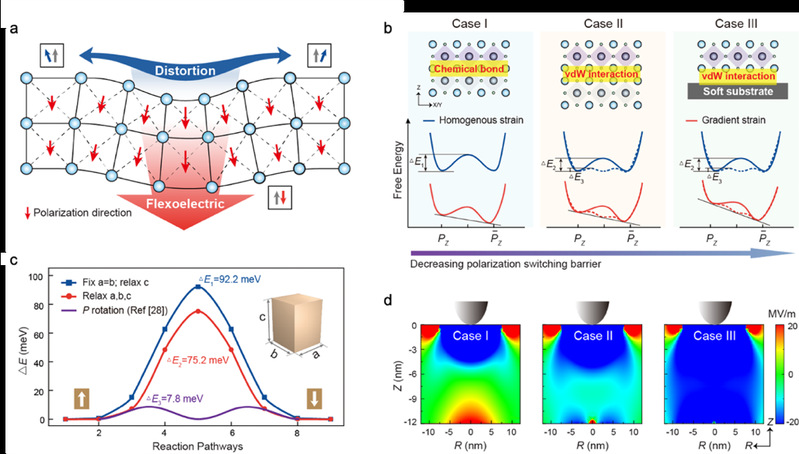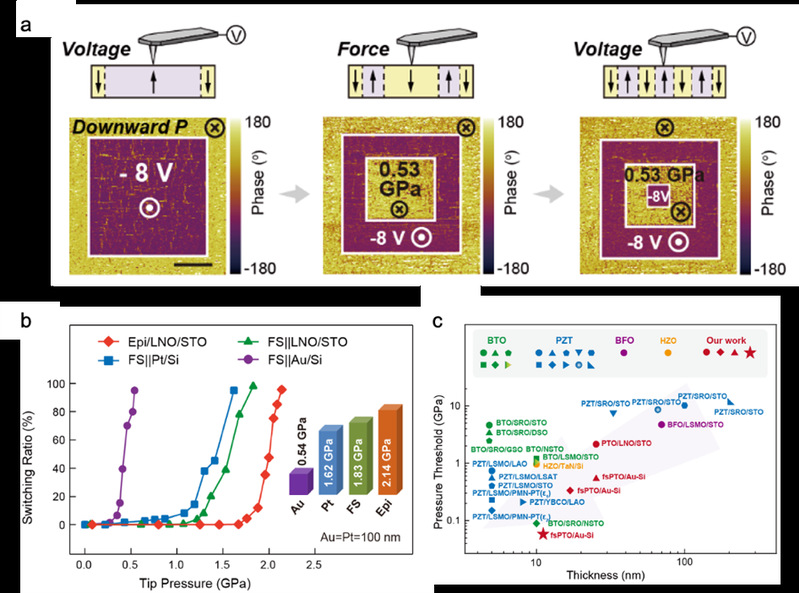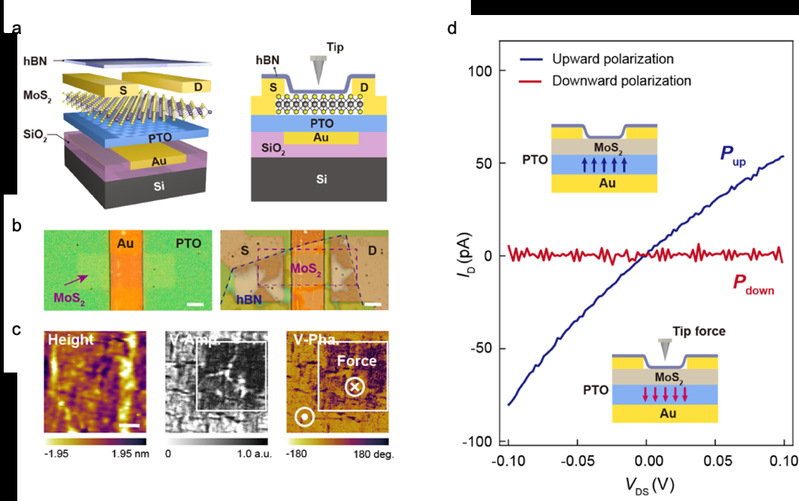Recently, a research group from Nanjing University has achieved a record low threshold pressure (0.06 GPa) of mechanical polarization switching in ferroelectric freestanding membranes. Moreover, as an application demonstration, researchers has constructed a prototype non-volatile ferroelectric field-effect transistor (FeFET) that can be operated mechanically and electrically on silicon. This is reported by an article in the latest issue of NatureCommunicationswith the title “Ultralow-pressure-driven polarization switching in ferroelectric membranes” (DOI: 10.1038/s41467-024-53436-6).
In recent years, the growing maturity of exfoliation and transfer technology on the freestanding oxide thin films has offered novel perspectives for achieving non-epitaxial hetero-integration of functional oxides and two-dimensional semiconductors and exploring new high-performance electronic devices. For instance, by stacking freestanding ferroelectric membranes with two-dimensional materials such as MoS2, ferroelectric field-effect transistors can be fabricated on semiconductor wafers like silicon single crystals. Simultaneously, as the freestanding membranes are not rigidly confined by the substrate, they can attain strain gradients far beyond those achievable in bulk or epitaxial thin films. Through the flexoelectric effect, it is anticipated to realize new types of two-dimensional field-effect devices that are compatible with force and electrical erasure.
As depicted in Figure 1, this work exploits the freely deformable characteristic of freestanding membrane, in conjunction with the innovative design of flexible metal bottom electrodes, to achieve polarization reversal control under ultra-low pressure. In contrast to epitaxial thin films constrained on the substrate, freestanding membranes permit more free lattice distortion and offer more selectable polarization reversal paths, thereby effectively reducing the barrier for ferroelectric polarization switching. Taking freestanding PbTiO3 (PTO) thin films as an example, theoretical calculations indicate that allowing changes in the in-plane lattice constant can significantly lower the energy barrier for 180-degree out-of-plane polarization flipping; if polarization can occur through 90-degree rotation as an intermediate state, the energy barrier will be further substantially reduced. The reversal of ferroelectric polarization can take place under the drive of the applied electric field and the flexoelectric field, where the flexoelectric effect refers to the polarization phenomenon resulting from the strain gradient in the material. Selecting metals with a lower Young's modulus as the substrate can generate a larger strain gradient in the freestanding membrane, thereby inducing a larger flexoelectric field. Hence, by integrating the feature of the significant reduction of the barrier due to the free deformation of the self-supported film and obtaining a larger flexoelectric field through the flexible substrate, efficient force field regulation of the ferroelectric domain structure can be accomplished in the freestanding film.

Fig.1 Design schematics for low-pressure-driven polarization switching in PbTiO3 membranes.
Researchers fabricated high-quality freestanding PTO films via oxide molecular beam epitaxy and transferred them onto different substrates to explore the reversible erasable and writable characteristics of the ferroelectric domain structure under the action of electric and mechanical fields (Fig. 2). Experimental comparisons revealed that the constraint of the substrate and the Young's modulus of the substrate had a significant impact on the threshold pressure for polarization switching in the freestanding PTO membranes: the softer the substrate, the lower the required threshold pressure, which was consistent with theoretical calculations. In the freestanding PTO films with a thickness of 8 nm, the polarization switching driven by the mechanical field at an ultra-low pressure (0.06 GPa) was achieved, which is the lowest value reported to date.

Fig.2 Ultralow switching pressure (0.06 GPa) in PbTiO3 membranes.
Furthermore, the research team also heterogeneously stacked the freestanding PTO membranes with the two-dimensional material MoS2. With PTO serving as the gate dielectric layer, MoS2 as the channel material, and gold as the back gate electrode, a ferroelectric field-effect transistor was constructed (Fig. 3). Through inducing a flexoelectric field in the PTO layer film by stress, the reversal of ferroelectric polarization was achieved to modulate the transport properties of MoS2, successfully realizing a field-effect transistor which is compatible with both electric and mechanical field regulations.

Fig. 3 A prototype non-volatile ferroelectric field-effect transistor (FeFET) that can be operated mechanically and electrically on silicon.
In this work, the property of freestanding membranes that can freely deform to significantly lower the polarization switching barrier was exploited, and the force-field control of ferroelectric domains at an ultra-low pressure of 0.06 GPa was achieved by obtaining a larger flexoelectric field through flexible substrates. Additionally, a non-volatile ferroelectric field-effect device compatible with both force and electric erasure was integrated on a silicon substrate by hetero-stacking with two-dimensional materials, showcasing the application prospects of freestanding oxide thin films in novel high-performance devices.
Dr. Xinrui Yang, Dr. Lu Han from College of Engineering and Applied Sciences, Nanjing University, Dr. Hongkai Ning from School of Electronic Science and Engineering and Collaborative Innovation Center of Advanced Microstructures, Nanjing University, Shaoqing Xu, a PhD student at School of Aerospace Engineering, Beijing Institute of Technology, and Bo Hao, a PhD student at College of Engineering and Applied Sciences, Nanjing University, are co-first authors of the paper. Professor Yuefeng Nie, Professor Xinran Wang, and Dr. Lu Han are co-corresponding authors. Professor Di Wu, Yi Shi, Jian Zhou of Nanjing University, and Jiawang Hong of Beijing Institute of Technology provided important guidance for this work. This work was supported by the National Natural Science Foundation of China, the National Key Research and Development Program of China, the Changjiang Scholars Program of the Ministry of Education, the Beijing Natural Science Foundation, China National Postdoctoral Program for Innovative Talents, China Postdoctoral Science Foundation, and the Xiaomi Foundation; in addition, National Laboratory of Solid State Microstructures, Jiangsu Key Laboratory of Artificial Functional Materials, and the Chongqing Supercomputing Center provided important support for this research.

